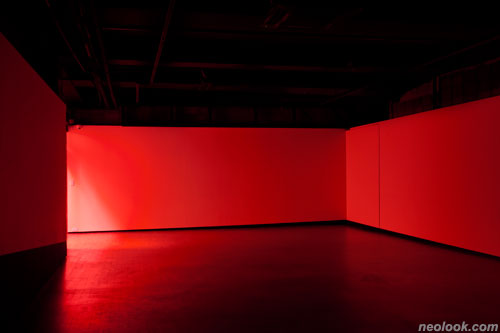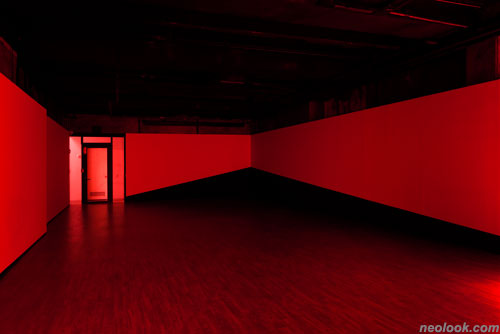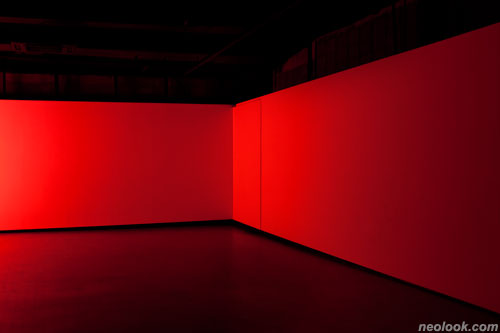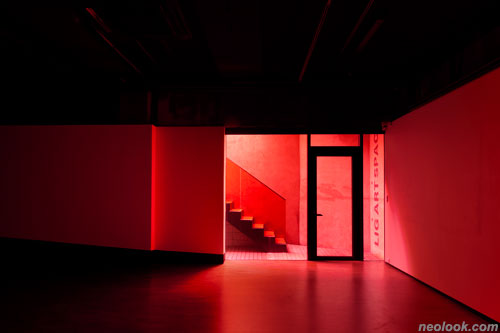- ● homepage
- ● archives
- ● restoration
- ● books
- ● big banners
- ● post board
- ■ neo's search
- ■ about us
- ■ 게재방법 안내
- 개인정보처리방침

- [email protected]
- Tel. 02_335_7922
- Fax. 02_335_7929
- 10:00am~04:30pm
- 월요일~금요일
- 3/3(월) 대체공휴일

공제선_붉은섬 (Skyline_Red Island)
정승운展 / CHUNGSEUNGUN / 鄭勝云 / installation 2016_0818 ▶ 2016_0908 / 일요일 휴관
● 위 이미지를 클릭하면 네오룩 아카이브 Vol.20140708i | 정승운展으로 갑니다.
초대일시 / 2016_0818_목요일_05:00pm
관람시간 / 10:30am~06:30pm / 일요일 휴관
LIG 아트스페이스 한남 스튜디오 엘 LIG ARTSPACE HANNAM STUDIO L 서울 용산구 대사관로11길 30 수가빌딩 B1 Tel. +82.2.6405.5700 www.ligartspace.com
'붉은 섬'으로 미술의 경계를 묻다 ● 2009년 '공제선(空際線)'이라는 주제로 처음 작품을 발표한 정승운이 2016년 여름 한남동 LIG아트스페이스의 전시장을 '붉은 섬', '홍도(紅島)'로 바꾸어 놓았다. 이번 전시의 제목은 『공제선-붉은 섬』이다. 작가는 2014년 소마미술관의 『건축적 조각』전에 「공제선-홍도」라는 공간 설치물을 선보인 바 있는데, 이번 개인전에서는 부제를 '홍도'에서 '붉은 섬'으로 바꾸고, 전시장 안에 목조 구조물을 설치하는 대신 전시장의 건축적 구조를 작품의 틀로 활용하는 장소특정적 설치 작업을 제시했다. ● LIG아트스페이스의 스튜디오 L은 한남동 한 건물의 지하에 위치하고 있는데, 정승운은 유리로 된 이 스튜디오 L의 진입계단과 유리문에 붉은 투명 필름을 부착하여, 낮 동안 지하 전시장 내부로 붉은 빛이 유입되도록 했다. 흔히 현대미술 전시장은 내벽을 화이트 큐브(white cube)로 처리하고 자연광을 차단하여 인공조명 속에 작품을 전시한다. 없는 듯 존재하는 전시장의 물리적 중립성을 전제로 미술작품이 설치되고 감상되는 것이다. 그런 전시장의 건축적 구조를 작품의 핵심적 틀로 드러내 사용한 것이 이번 정승운의 '붉은 섬'이 갖는 해법이다. 전시기간 후에는 사진으로 밖에 남을 수 없는 이 작품은 건축적 공간에 의지하여 존재하는 작품이며, 작품의 관람은 현장을 찾은 관람자의 현상학적 체험으로 이루어진다. 작가가 제시하는 '붉은 섬'을 제대로 만끽하려면 여름날을 기준으로 하여 해가 슬며시 기울어지는 오후 4-5시경이 적격이라 시간특정적 작업이기도 하다. ● 관람객은 붉은 필름이 선팅(sunting)된 진입로를 따라 건물 지하에 위치한 스튜디오 L로 들어와 불 꺼진 전시장 내부에서 역설적으로 밝은 외부의 빛을 인식하게 된다. 지상의 빛은 성큰 가든(sunken garden)처럼 외부의 빛을 끌어들이는 지하 전시장에 붉은 반사광을 드리운다. 우리는 좀 전까지 그 빛 속에 있었지만, 그 빛이 부분적으로 차단되고 일정하게 변조된 건물 내부에서 비로소 그 빛을 새롭게 발견한다. '아' 하는 탄식과 함께 우리는 홍도의 붉은 빛과 바다 위의 붉은 섬, 홍도가 위치한 수면의 감각을 살짝 경사지게 사선으로 도색한 전시장 바닥면에 발을 딛고 온 몸으로 체험하며 지각으로 인지한다.

- 정승운_공제선-붉은섬_필름설치, 벽에 채색_2016

- 정승운_공제선-붉은섬_필름설치, 벽에 채색_2016
푸른 서해바다를 배경으로 낙조에 특히 아름답다는 홍도는 홍갈색을 띤 규암으로 이루어진 섬이며, 동백꽃이 섬을 뒤덮을 때면 섬 전체가 붉은 옷을 입은 것 같다 하여 홍의도(紅衣島) 또는 홍도(紅島)라 불리게 되었다고 한다. 한반도 남서부 신안군 앞바다에 위치한 홍도는 작가의 고향인 강진에서 가까운 섬을 가리키지만, 그의 '붉은 섬'은 특정 섬을 지칭하기보다 자연 일반을 제유(提喩)하는 존재에 가깝다. 앞서 발표된 정승운의 공제선 연작 중 '청산(靑山)'이 고향의 월출산에서 시작하여 땅 위의 푸른 산, 즉 자연과 세상을 대변하는 존재로 확장되는 것과 같다. 정승운의 공제선 연작에서 '푸른 산'과 '붉은 섬'은 아름다운 시각적 댓구를 이루며 자연의 여러 모습을 대변하는 매개변수로 변주되고 있다. ● 2009년부터 정승운이 작업의 제목으로 사용한 '공제선'의 사전적 의미는 '능선처럼 하늘과 지형이 맞닿아 이루는 선', 즉 스카이라인(skyline)을 뜻한다. '나'를 형성한 고향 산천은 언제나 특별한 감회를 일으키지만, 그것이 무엇인지를 설명하기란 쉽지 않다. 미술대학에서 회화를 전공한 정승운은 졸업 후 독일에 유학하며 회화가 아닌 개념적 설치의 방법으로 전환한 것으로 보인다. 그는 그 시절 회화의 전제를 떨쳐버리려 했던 기억을 인상 깊게 설명한다. 예술가에게 특별한 의미를 갖는 고향의 자연을 그림으로 그리는 것, 혹은 내면의 감정을 붓질과 물성으로 드러내는 것, 그것은 회화의 당면한 과제였고, 그런 회화는 예술을 전제했다. 화가의 주변 환경 혹은 내면을 붓질과 물감으로 형상화하는 것은 암묵적인 예술의 실천인 셈인데, 그런 회화는 어떤 방법으로 이루어져야 하며, 회화는 왜 예술인지를 따져 묻는 질문은 철저하게 검증되지 않은 채 우리에게 당연한 과제로 부과되었다. ● 본능적이고 직관적인 회화의 버릇을 떨쳐내고 개념적 설치로 전환한 정승운의 창작 방법론은 논리적 추론에 입각하여 수학적 계산과 엄격한 법칙에 따라 전개된다. 대상의 가변적 현상을 제거하고 본질적 개념에 접근하려는 정승운의 방식은 철저한 고전주의자로서의 면모를 드러내는데, 그 속에서 언뜻언뜻 회화적 감성과 시적 공명이 드러나는 것을 막을 수 없다. 국내에서 대학을 졸업하고 1990년부터 독일에 유학한 정승운의 이력 중, 1994년부터 1999년까지 재학한 뒤셀도르프 쿤스트 아카데미의 지도교수가 야니스 쿠넬리스(Jannis Kounellis)인 점이 눈길을 끈다. ● 1936년 그리스의 항구도시 피레우스에서 태어난 쿠넬리스는 1956년 로마에 유학하며 미술에 입문했으며 이후 이탈리아의 전위미술 운동 아르테 포베라(Arte Povera)의 대표적인 작가로 활동했다. 비정통적인 재료를 사용하여 일상에서 발원하는 시적 언급을 창출하고자 가장 단순한 방법으로 작품을 만드는 '가난한 미술' 아르테 포베라는 1967년 이탈리아 북부 여러 도시에서 이탈리아 출신의 미술가들이 의기투합하여 결성한 현대미술 단체였다. 전후(戰後) 아방가르드의 부활을 의미하는 이 운동은 미니멀리즘이나 개념미술, 대지미술 등 미국의 현대미술이 유럽에 유입되면서 그에 자극받은 유럽 미술가들이 비판적 대응으로 발전시킨 미술이었다. 아르테 포베라는 소박한 재료에 단순한 방법으로 삶에 기반한 예술을 제시한다는 점에서 참신한 의미의 전환을 가져왔는데, 이후 이탈리아 출신의 미술가들뿐만 아니라 북유럽과 미국 출신의 미술가들이 가세하면서 국제적인 현대미술로 명성을 얻은 바 있다.

- 정승운_공제선-붉은섬_필름설치, 벽에 채색_2016

- 정승운_공제선-붉은섬_필름설치, 벽에 채색_2016

- 정승운_공제선-붉은섬_필름설치, 벽에 채색_2016
전통적인 예술의 '창조' 개념보다 체계와 언어를 중시하며 보는 행위의 인식을 시각적 형상화로 연결시키는 것이 아르테 포베라의 대표적인 특징이기에, 정승운의 변화는 쿠넬리스와 뒤셀도르프 아카데미의 수학 과정에 이루어진 것임을 짐작할 수 있다. 쿠넬리스는 독일 현대미술의 중요한 계보를 형성하는 뒤셀도르프 아카데미에 1993년부터 2001년까지 교수로 재직했는데, 이 시기는 정승운의 독일 유학 후기와 일치한다. 유학 전 정승운이 독일식 표현주의 회화에 익숙했다면, 뒤셀도르프 아카데미 수학에 수학하면서 개념주의적 설치 미술로 바뀐 것으로 볼 수 있다. 정승운은 이러한 전이를 통해 이성적・논리적 토대와 현실적・감각적 체험을 병행하는 아르테 포베라 식 현대미술을 자신의 작업의 근간으로 삼게 된 것으로 보인다. ● 1990년대 말 이후 정승운의 작업은 일정한 개념적 정의를 논리적으로 추론하여 조형적으로 구체화하는데 집중되었다. 귀국 후에는 특히 인간의 삶이 이루어지는 세상, 개인의 정체성을 구성하는 집과 고향, 인간의 귀속감을 불러일으키는 자연과 세상의 의미를 추상적으로 사유하고 그 생각의 변주를 특수한 조형적 실천으로 가시화했다. 대상을 언어적 정의나 수학적 공식, 논리적 도식 등으로 추상화하면서, 그 관념을 다시 현실화하는 정승운식 미술의 실천은 '집' '숲' '꿈'이라는 글자를 평면의 드로잉과 채색으로 전개하거나, 나무판을 잘라낸 면의 중첩으로 설치하고, 글자를 따라 박은 작은 못들을 실로 연결하고, 스테인리스 봉을 용접하여 난형 구조물을 만드는 등 매번 방법을 달리하며 실행에 옮겨졌다. 대상에 대한 관념적 파악이 엄격한 규칙을 따르는 만큼, 그의 조형적 실천도 묘기에 가까운 정교함으로 이루어졌다. 못이나 접착제를 사용하지 않고 커다란 사각의 목조 구조물을 기둥 상단에 구조물을 구성하는 면들 간의 장력만으로 매달려 있게 하거나, 한눈에 파악하기 힘든 산 전체의 능선을 파노라마식 선묘로 따내고, 하늘을 가르는 능선처럼 전시 공간에 내걸릴 실위에 유채물감으로 풍경화를 그리거나, 파란 눈금의 제도용지를 구겨 심산의 계곡과 능선을 구현하는 등 정승운은 매번 머릿속 개념을 구체적인 재료와 엄격하게 규율화 된 공정에 따라 다양하게 현실화했다. ● 회화가 삼차원의 공간을 이차원의 평면에 담는 것이라면, 정승운은 그것을 한 번 더 압축하여 이차원의 선에 담거나, 아니면 삼차원을 이차원으로 도면화했다가 다시 삼차원으로 조형화하고, 무형의 개념을 유형의 구조물로 형상화 등 연속적인 차원의 변주로 전개해나갔다. 그의 개념적・조형적 변주는 회화의 특권을 묻고 회화의 전제에 도전하는 것으로, 전통적인 미술의 경계 밖에서 미술을 묻고 무효화하여 확장하는 경로를 따른다. 그럼에도 불구하고 전통적인 미술의 경계를 허무는 그의 작업이 여전히 미술인 것은 그가 개념적 추론과 논리적 분석을 지속적으로 감각적으로 시각화하며 구체화한다는 데 있다. 특수성을 추상화하고 추상적인 것을 다시 구체화하는 과정을 통해 그는 이미 존재해왔던 것을 새롭게 인식하는 각성의 순간을 선사한다. 그의 작업은 비 회화의 실제효과로 보이지 않는 것을 보이도록 하고, 평범한 삶을 특별한 순간으로 재경험하게 하는 일종의 입문의식으로서의 예술에 가깝다.

- 정승운_공제선-붉은섬_필름설치, 벽에 채색_2016
2002년부터 2009년까지 이어진 정승운의 '집 숲 꿈' 연작이 언어적 체계를 여러 방식으로 변주시켜 왔다면, 2009년 이후의 '공제선' 연작은 문자의 기호를 시각적 형상으로 대체한 점에서 다르다. '집'의 반복이 '숲'으로 이어지고 거기서 '꿈'을 발견했듯이, 정승운은 고향의 월출산을 '공제선'으로 옮기는 과정에 '청산'을 발견하고, 땅 위의 푸른 산, '청산'은 다시 바다 위의 붉은 섬, '홍도'로 대위법적 변주를 이룬다. '집 숲 꿈' 연작에서 작품의 의미가 문자의 기의적 함의에 국한되는 것에서 벗어나려 했다면, '공제선' 연작에서 청산과 홍도는 특정 지명을 의미하기보다 보편적 자연과 세상이라는 보다 넓은 개념을 지향한다. 이러한 정승운의 작업에서 형태와 색채를 도구로 삼는 회화의 관례가 개념적인 형상과 색채로 대체된 점이 흥미롭다. 집은 재현적 형상이 아닌 문자적 형태로 대변되고, 삼라만상의 자연은 공제선으로 압축되며, 화가에게 중요한 색채는 가장 검은 먹색과 가장 붉은 경면주사(鏡面朱砂) 등 관념적 색채로 한정되었다. 푸른 물감과 붉은 물감을 화면에 바르던 회화적 제스처는 '푸른 것'은 무엇이며, '붉은 것'은 무엇인지를 묻는 질문으로 대체되었다. 개념을 물질화하는 방법에도 일정한 질서와 규칙이 도입되는데, '청산'과 '홍도'로 변주되는 대립적 개념은 파란 눈금의 제도용지를 구겨 청산을 만들거나 붉게 칠한 목조의 기하학적 구조물로 홍도를 구체화하는 방식으로 실행되었다. 정승운의 작업에서 사유와 논리는 기하학적 형태와 관념적 색채, 현상학적 상황으로 재현실화된다. ● 문자 그대로 키스톤을 보여주고 석양에 붉게 물든 섬을 감각적으로 재연할 수 있다면 우리의 앎은 구체적인 경험으로 육화될 수 있을 것이다. 그의 미술은 보이는 것을 관념화하고 보이지 않는 관념을 보이도록 하는데 목표를 둔다. 본능적 필치와 우연적 감성에 내맡기지 않고 개념적 정의로 추론된 논리를 일정한 법칙에 따라 우리 눈앞에 구체화시켜주는 정승운의 작업은 붉은 섬이 붉은 섬인 이유를 우리의 머리와 몸에 선명하게 각인시켜준다. 엄격하게 계측하고 공들여 구성하여 보여주는 푸른 산과 붉은 섬의 의미는 지적 인지와 감각적 체험을 통해 동시에 전달되기에 세상과 삶에 대한 산뜻한 각성의 순간을 선사한다. 그리고 인지와 직관을 병행하는 그의 작품을 체험하는 순간은 존재에 대한 확인으로 반사되어, 우리는 삶과 미술, 나와 세계에 대한 일신된 믿음을 환기하게 된다. ■ 권영진

- 정승운_공제선-붉은섬_필름설치_2016

- 정승운_공제선-붉은섬_필름설치_2016
Questioning the Limits of Art through Red Island ● Chung Seung Un, who debuted his first work entitled Skyline in 2009, has embellished the exhibition hall of LIG Art Space in Hannam-dong with Hongdo, or Red Island in the summer of 2016. The present exhibition is entitled Skyline_Red Island. Chung has already produced a spatial establishment in the Space Craft exhibition that is displayed at the Seoul Olympic Museum of Art. In the current individual exhibition, the subtitle has changed from Hongdo to Red Island, suggesting a space-specific installation work that utilizes the structure of the exhibition hall as a framework instead of wooden structures inside the studio. ● Chung attached pieces of red cellophane paper to the glass stairs and entrance of studio L, which is located in the basement floor of a building in Hannam-dong, so that red light flows into the exhibition hall in the daytime. It is common for exhibition halls for modern art to tidy up the inner walls as the white cube and block the sunlight, instead displaying works under artificial lighting. It is on this physical neutrality—which is seemingly nonexistent but certainly exists—that artworks are installed and appreciated. Challenging this convention, Chung's Red Island suggests another method of utilizing the exhibition halls: revealing their as the central framework of artworks. Given that it can only remain in pictures taken after the exhibition, the existence of Red Island relies on the structural space of the studio, and the appreciation of the work is only possible through the visitors' phenomenological experience. This work is also time specific in that 4:00 to 5:00 on summer afternoons, when the sun starts to set slightly, is the most suitable time to appreciate the real red island as the artist presents it. ● Only after walking all the way through the entrance corridor, which is tinted with red cellophane papers, and entering Studio L in the basement do visitors come to perceive the brilliance outside and, ironically, inside the dim studio. The basement hall, which consumes outside light just like the sunken garden, is saturated with red reflections from the light above the ground. Though the visitors were steeped in the light outside a while ago, it is only inside the building where the light is partially blocked and consistently varied that they eventually rediscover it. With the expression, "Alas," we place our feet on the floor of the studio, which is painted somewhat diagonally with the red reflections of Hongdo, the red island on the ocean. The sensation of the watery surface on which the island is located is experienced throughout the visitors' bodies. ● Extraordinarily scintillating in the setting sun against the backdrop of the emerald-tinged West Sea, Hongdo is made of reddish-brown quartzite. It came to be called Hongeuido, or Hongdo, because the entire island looks as if it is wrapped in red clothes when it is blanked with camellia flowers. The beautiful island, which is in the coastal waters of Shinan-gun in the southwest part of the Korean peninsula, is referred to as an island close to Gangjin, the artist's homeland. However, his Red Island goes beyond indicating a specific island and becomes a synecdoche for Mother Nature in general. This is in line with Blue Mountain, a work from the Skyline series that begins with Wolchul Mountain in his hometown and expands toward a blue mountain on the Earth that represents nature and the world. In the Skyline series Blue Mountain and Red Island appear to be a visually rhyming couplet, and they are used to represent various scenes in nature. ● The definitive meaning of Skyline, which has been used as the title of Chung's works since 2009 as "the line similar to a ridge formed by the contact of the sky and the ground." For Chung, mountains and streams from his hometown never fail to arouse special sentiment, though that sentiment hardly explains what they are. After majoring in painting in an art college, Chung studied in Germany after graduation. This period seems to have played a huge role in making him convert from painting to conceptual establishment. He explains with great emotion his memories of trying to let go of the practices of painting. Drawing one's homeland has a special meaning for artists, as does revealing one's innermost emotions with brush strokes and material properties, which precedes the task of painting, which in turn precedes art. Representing surrounding circumstances or inner feelings through brush flicks and paint can be a tacit practice of art, but it raises questions such as how such paintings should be realized, why painting is art, or why painting is imposed on us as a natural principle without going through a thorough verification process. ● Having escaped the instinctive and intuitive habits of painting and converted to conceptual establishment, Chung sets forth his creation methods according to mathematical calculations and strict principles that are based on logical reasoning. His method of eliminating the variable representations of the subject and trying to create access to its essential concept reveals one aspect of him being a thorough classicist, which cannot stop his artistic sentiments and poetic resonances from showing up here and there. One notable thing about his graduation from a Korean college and subsequent study in Germany from 1994 to 1999 is that, during the period when he studied at Dusseldorf Kunst Academy, his academic adviser was Jannis Kounellis. ● Born in the Greek port city of Pireus in 1936, Kounellis initiated his study of art in Rome, Italy in 1956. Afterwards he became famous as the most representative artist of Arte Povera, an avant-garde art movement that began in Italy. Arte Povera, or "Poor Art," artists were known for creating works through simple methods using unconventional materials in order to produce poetic references to daily life. Arte Povera was originally a modern art group organized by Italian artists from various Northern cities in 1967. Signifying the resurrection of post-war avant-garde art, the campaign was part of the art that European artists created in their critical response to the influx of American modern art styles such as minimalism, conceptual art, and earth art. Arte Povera brought fresh meaning in that it promotes art based on real life through simple methods and humble materials. Afterwards, it became a fad in modern art throughout the world with the growing support of not only Italian artists but also Northern European and American artists. ● The main features of Arte Povera are emphasizing scheme and language rather than the traditional art concept of "creation" and connecting the perception of the act of seeing with visual shapes. The changes in Chung's works seem to be influenced by Kounellis and his studies at Dusseldorf Kunst Academy. Kounellis worked as a professor in an academy that continues a major lineage of modern art in Germany from 1993 to 2001, the period corresponding with the late part of Chung's study period in the nation. Before studying at Dusseldorf, Chung was familiar with German expressionist paintings. However, while studying in Dusseldorf Kunst Academy, he became very interested in conceptual installation art. Through this transition, Chung seems to make Arte Povera style modern art founded on a combination of a rational, logical base and realistic, sensory experiences. ● Since the late 1990s, Chung has focused on logically deducing certain conceptual definitions and formatively embodying them in his works. Since returning home, he has meditated on the abstract meaning of the world that humans live in, how houses and hometowns form identity, and how nature and the world arouse a sense of belonging. Then he visualized variations of his ideas in a special formative practice. Chung's art practice involves abstracting of objects with linguistic definitions, mathematical formulas, and logical diagrams. Chung realized the related ideas in a different way every time he tried it: displaying the words "house," "forest," and "dream" with flat drawings and coloring; superposition of wood plates in such a way that they pile up on each other's cut faces; connecting the small nails driven in according to letter shapes; and welding stainless steel rods to make oval structures. As the conceptual perception of objects follows strict rules, his formative practice is also carried out in an exquisite way that resembles wizardry: fixing a large square wood structure on the top of a pillar using only the tension between the sides composing the structure without nails or glue; expressing the entire ridge of a mountain that cannot be seen at a glance with a panoramic drawing technique; drawing a landscape with oil paint above the strings to be hung over the exhibition space as a bridge that crosses the sky; and crumpling drafting paper with blue gradation to embody valleys and ridges of deep mountains, These examples demonstrate how he gives shape to the concepts in his mind with specific materials and a process he strictly follows as a discipline in various ways. ● While painting can be seen as an act of putting three-dimensional space into a two-dimensional plane, Chung proceeds to compress it once again and put it in two-dimensional lines by drawing a three-dimensional object on a two-dimensional plane and then again molding it into a three-dimensional sculpture, or giving shape to an intangible concept by embodying it in a structure. In such a way, he develops his works as a continuous variation of dimensions. His conceptual and formative variation poses questions about the privilege of painting and defies the premise of painting, thereby following a process of questioning art outside its traditional boundaries, nullifying it, and then expanding it. Nevertheless, his works that break down the boundaries of traditional art are still art because he continues to sensuously visualize and materialize his conceptual reasoning and logical analysis. Through the process of abstracting the specific and materializing the abstract again, he presents us with a moment of awakening in which we have a new perception of the thing that already existed. His work allows the unseen to be seen through the realistic effect of non-painting and leads us to re-experience pieces of our ordinary life as special moments. Therefore, his works are like an artistic initiation ritual for such experiences. ● Chung's House, Forest, Dream series that was developed from 2002 to 2009 presented variations of a linguistic system in a variety of ways. However, the Skyline series, which he started in 2009, is different from the former in that it replaces literal symbols with visual shapes. As the continuous juxtaposition of Houses leads to Forest where Dream was discovered, Chung discovers Cheongsan (Blue Mountain) in the process of putting Wolchul Mountain from his hometown into Skyline. The blue mountain on the land, Cheongsan, forms a contrapuntal variation to the red island on the ocean, Hongdo. While he tried to avoid confining the meaning of his works to the signified implication of letters in the House, Forest, Dream series, this time, in the Skyline series, he seeks to represent a universal nature and world with a blue mountain and red island instead of referring to specific places. ● An interesting point is that in Chung's work here, the custom of painting using shapes and colors as tools was replaced by conceptual shapes and colors. Houses were embodied by literal form rather than representational shapes, and the nature of all creation was compressed into skylines. Also, colors that had great significance to painters were limited to conceptual ones: the deepest black of meok (Korean traditional ink) and the deepest red of cinnabar. The gesture of painting that Chung used to spread blue and red paints on canvasses was replaced by questions asking what "blue thing" or "red thing" really are. As for how the concepts materialized, certain orders and rules were introduced, as shown in the opposing concepts expressed in the variations of blue mountains and red islands. He gave shape to blue mountains by crumpling drafting paper with blue gradation and red islands with geometric wood structures painted red. In Chung's work, reasoning and logic are newly introduced to reality through geometric shapes, conceptual colors, and phenomenological situations. ● If Chung can literally show us his hometown and sensuously reproduced an island colored red by the setting sun, our knowledge of the island will translate into specific experiences. The goal of his art is ideating the visible and materializing the invisible. Chung's works, which rely on logic and conceptual definition rather than instinctive touch and random sensibility, indelibly imprint why a red island is a red island on our minds and bodies. The meaning of blue mountains and red islands shown in a strictly-measured, carefully-organized composition offers a fresh moment of awakening toward the world and life because it involves intellectual perception and sensuous experience at the same time. In addition, the moment of experiencing his works in combination with perception and intuition leads to confirmation of existence and renews our belief in life, art, ourselves, and the world. ■ Kwon Young-Jin
Vol.20160818d | 정승운展 / CHUNGSEUNGUN / 鄭勝云 / installation

